陕旅版六年级英语下册教学计划
- 格式:doc
- 大小:29.00 KB
- 文档页数:3

格式,下载后您可任意编辑修改!Lesson 1 Xi’an is a beautiful city.本课谈论的是旅游方面的话题,对话内容侧重于旅游前的准备活动。
通过学习使学生乐于并能主动和别人用英语谈论旅游的话题。
学生要掌握一些和旅游活动相关的句子和短语,例如Where are you going?\ Who will take you there?\Are youready for your trip?\ Shihuang’s Terra-cotta Warriors and Horses; The Bell Tower; the Great Wall; the Weat Lake.3.理解会用一般将来时态的两种表达法:I’m going to …\ I will…4. 会说会用常用语:take a picture of…\ be ready for \ ticket. Why are you ticket, too.B: Where are you going?A: I’m going to go to Sichuan.B: Who will take you there?A: My brother. Where are you going?B: Beijing. I’ll visit my grandparents.教师利用CAI课件上的景点图片或是照片讲解本课重点词汇和句型。
1)景点词汇教授。
教师播放CAI让学生感知图片,然后出示各个景点照片一一教授。
教师用简单的句型描述一个景点,让学生们猜猜那是什么。
e.g It’s very famous and great.It’s in Xi’an.It’s about the Qin Dynasty.从而引出秦始皇兵马俑,教师教授英文单词----- Qin Shihuang’s Terra-cotta Warriors And Horses.The Bell Tower 钟楼The West Lake 西湖The Great Wall 长城教法从上。
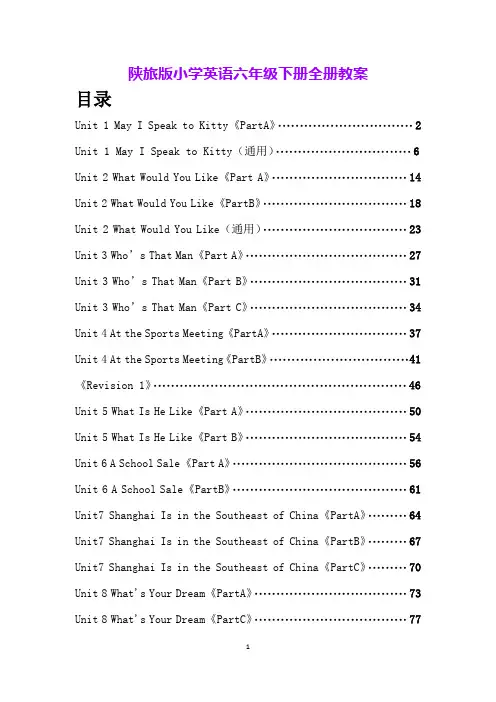
陕旅版小学英语六年级下册全册教案目录Unit 1 May I Speak to Kitty《PartA》 (2)Unit 1 May I Speak to Kitty(通用) (6)Unit 2 What Would You Like《Part A》 (14)Unit 2 What Would You Like《PartB》 (18)Unit 2 What Would You Like(通用) (23)Unit 3 Who’s That Man《Part A》 (27)Unit 3 Who’s That Man《Part B》 (31)Unit 3 Who’s That Man《Part C》 (34)Unit 4 At the Sports Meeting《PartA》 (37)Unit 4 At the Sports Meeting《PartB》 (41)《Revision 1》 (46)Unit 5 What Is He Like《Part A》 (50)Unit 5 What Is He Like《Part B》 (54)Unit 6 A School Sale《Part A》 (56)Unit 6 A School Sale《PartB》 (61)Unit7 Shanghai Is in the Southeast of China《PartA》 (64)Unit7 Shanghai Is in the Southeast of China《PartB》 (67)Unit7 Shanghai Is in the Southeast of China《PartC》 (70)Unit 8 What's Your Dream《PartA》 (73)Unit 8 What's Your Dream《PartC》 (77)Unit 1 May I Speak to Kitty?《PartA》1教学目标知识与技能目标:1.我能听懂、理解并熟读Let’s talk 部分的对话内容。

Unit 1 May I speak to kitty?共有 4 课时第 1 课时教学内容:May I speak to kitty?教学目标:1、理解会说会用会写以下单词和短语Mobile phone. Make a phone call. Go to the Internet. Send a message. Read an e- book. book.Send an e-mail.2、能准确理解本课内容,并能在实际生活中和别人进行打电话练习。
教学重点:May I speak to…?This is …Is that…?Kitty is out.Ask somebody to do something.Sounds good.教学难点:能准确理解本课内容,并能在实际生活中和别人进行打电话练习。
熟练运用短语:Mobile phone. Make a phone call. Go to the Internet. Send a message. Read an e- book. book.Send an e-mail.教学准备:教师资源包教学方法:高效课堂模式。
教法:情景教学法,趣味游戏法。
学法:自主学习,合作探究。
教学过程:一、热身导入What do you think is the most useful?Number the following things from one to five.I… every day.二、新课展示Mobile phone. Make a phone call. Go to the Internet. Send a message. Read an e- book. book.Send an e-mail.2、学生试读3、引出句型May I speak to…?This is…4、讲述知识点Watch TV. Listen to the radio. Listen to MP3. Play games on the computer. Usea mobile phone.三、Look and chooseWhat news. Play games and. Listen to music Send an e-mail.Take photos. Call your friends.四、Let's talk.1.Kitty is out. Send out.2. Hello,may I speak to…?3. This is…4. Could you please ask… to…5. I'll tell her when she comes back.6. Is that…?7. Who is that?8. I will use it to make phone calls and send messages.五、拓展延伸1、Read the words and the dialogue .2、Preview part B.板书设计:课后反思:Unit 1 May I speak to kitty?共有 4 课时第 2 课时教学内容:May I speak to kitty?教学目标:1、复习巩固打电话的用法。
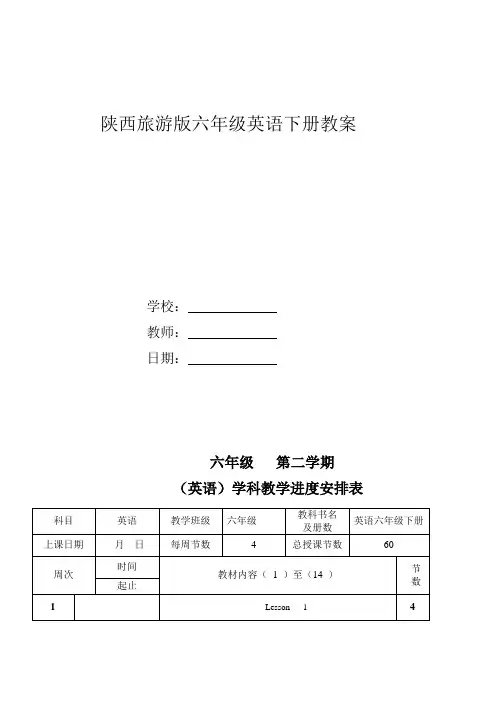
陕西旅游版六年级英语下册教案学校:教师:日期:六年级第二学期(英语)学科教学进度安排表陕西旅游版六年级英语下册教学计划一、教材分析:本教材注重学生审美感受和语言能力的培养,强调学生创新意识和实践能力的协调发展,以“接近社会、贴近学生、学以致用”为原则,选择符合六年级小学生身心特点的教学内容设计课题。
全册共有14个单元,内容涵盖打电话,方位表达,问路和指路,看病等,分配在各课之中。
教材特点:1.语言发展8.提供多媒体的配套材料。
二、教学方法及要求:(一)会话教学在会话教学中,教师应注意以下几点:1.融会话教学于情景表演之中,师生一起在表演中教,在表演中练,在交际活动中用,而不要将会话教学变成跟老师念跟录音读,集体、小组、个人读的枯燥无味的形式。
在会话表演中,教师的角色既是导演,又是演员。
表演可分为以下几种形式:1)语言的示范性表演2)语言的巩固性表演3) 发展语言技能的创造性表演(二)词汇教学在词汇教学中应注意以下几点:1.巧用实物、头饰和卡片2.融词汇于会话教学中力求做到在旧语言中学生词,用旧词练习新语言。
语言词汇的教学,相辅相成,不可分割。
利用并丰富教师教学用书中可供选择的游戏,可以根据内容的需要,选择一至两种游戏形式丰富课堂教学。
设计生动活泼的交际性语言活动。
3.充分发挥TPR活动的优势TPR活动深受儿童喜爱。
节奏和动作能刺激大脑皮层,激活记忆,使学生在对各指令的反应中自然习得语言。
TPR活动的操作方式:1) Listen,look and guess (听音、看图、猜意)2) Listen and point (听音指图)3) Listen and do (听听做做)4) Put them in random order (打乱顺序做)4.注意示范教学单词的发音5.单元词汇表上得这些单词是本册的教学重点,教师应详细教授它们的结构与书写。
(三)歌曲与歌谣教学要使歌曲和歌谣真正起到活跃教学,并服务于语言教学的作用,应注意以下几点:1. 在每节课中渗透2.灵活运用于各个教学环节中3.唱演结合,培养艺术素质(四)趣味故事教学每个单元的趣味故事不仅仅是给学生带来乐趣,更重要的是起到了扩展语言和对不同学生分层次教学的作用。
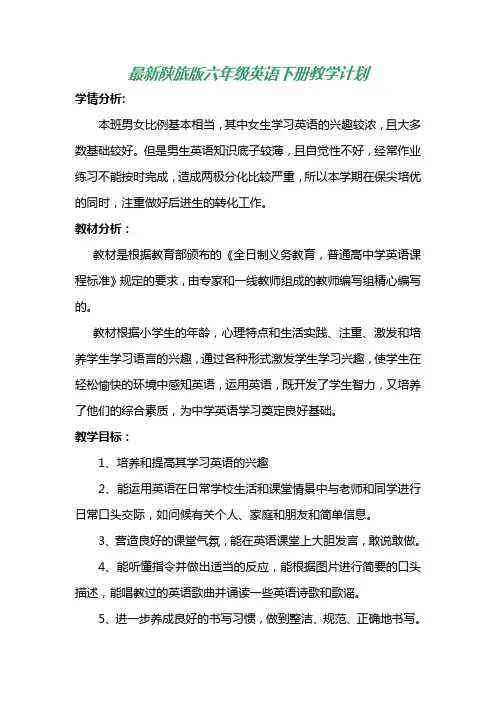
最新陕旅版六年级英语下册教学计划学情分析:本班男女比例基本相当,其中女生学习英语的兴趣较浓,且大多数基础较好。
但是男生英语知识底子较薄,且自觉性不好,经常作业练习不能按时完成,造成两极分化比较严重,所以本学期在保尖培优的同时,注重做好后进生的转化工作。
教材分析:教材是根据教育部颁布的《全日制义务教育,普通高中学英语课程标准》规定的要求,由专家和一线教师组成的教师编写组精心编写的。
教材根据小学生的年龄,心理特点和生活实践、注重、激发和培养学生学习语言的兴趣,通过各种形式激发学生学习兴趣,使学生在轻松愉快的环境中感知英语,运用英语,既开发了学生智力,又培养了他们的综合素质,为中学英语学习奠定良好基础。
教学目标:1、培养和提高其学习英语的兴趣2、能运用英语在日常学校生活和课堂情景中与老师和同学进行日常口头交际,如问候有关个人、家庭和朋友和简单信息。
3、营造良好的课堂气氛,能在英语课堂上大胆发言,敢说敢做。
4、能听懂指令并做出适当的反应,能根据图片进行简要的口头描述,能唱教过的英语歌曲并诵读一些英语诗歌和歌谣。
5、进一步养成良好的书写习惯,做到整洁、规范、正确地书写。
6、进一步养成听英语、读英语和说英语的良好习惯。
教学重点和难点:1、掌握所学“四会”单词、短语。
2、掌握所学句型。
主要措施:1、教学中,采用情景教学法,让学生身临其境,积极主动地参与到课堂教学中去,鼓励学生上课大胆发言,调动学生的非智力因素,提高学生实际运用语言的能力。
2、勤于观察学生掌握知识的情况,及时掌握学生学习英语的情况,课堂上尽可能照顾差生。
每天在上课前的几分钟内,对学生的单词、短语、句子进行抽查,掌握学生的学习情况。
3、通过听、说、读、写、唱、演、画、做等形式,进行大量和语言操练和练习。
4、每天坚持自己检查学生的作业和练习,且坚持在早读时检查学生的单词和课文的背诵。
课时安排:本册教材共八个单元,每单元四课时(即四节四十分钟)进行。

陕西旅游版小学六年级英语下册教案新寨小学六年级设计者:支彦军2016年2月26日陕西旅游版小学六年级英语下册教学计划一、教材分析:本教材注重学生审美感受和语言能力的培养,强调学生创新意识和实践能力的协调发展,以“接近社会、贴近学生、学以致用”为原则,选择符合六年级小学生身心特点的教学内容设计课题。
全册共有8个单元,两个复习课,内容涵盖打电话,职业,方位、表达自己的梦想等,分配在各课之中。
教材特点:1.强调语言运用2.注重能力培养3.突出兴趣激发4.重视双向交流5.融合学科内容6.重视灵活扩展7.实现语言发展8.提供多媒体的配套材料。
二、学情分析本班现有学生51人,其中女生20人。
六年级英语在小学英语教学中起着承上启下的作用,既是五年级的衍生又是初中一年级的铺垫。
我们的学生虽然已有三年半的英语学习经验,但还有以下一些问题需要解决。
(一)、存在的问题1、学习兴趣不是很高,部分学生甚至有厌恶感,同时,许多学生还是为学习而学习,谈不上兴趣问题;2、回家不会学习,无正确的学习方法,不知如何看书.学习态度谈不上十分端正,回家以后巩固时间很少,且缺乏有效的巩固手段,练的机会明显不足。
3、部分学生学习的目的性不是很强,导致学习习惯不好,学习无明确的计划,有作业就写,无作业就玩。
老师布置的作业不能按时完成,回家看书也只是应付家长,作业不能很好完成,作为语言性学科,听与读是非常关键的环节,而大多数学生这一点做的不好。
(二)、影响学情的阻抗因素1、家庭原因:部分家庭的家长在子女的教育方面缺乏有效的方法,有的只是简单的满足;有些家长本身的素质不是很高,同时一些思想给子女的学习造成了负面影响;父母的教育尺度不统一,他们当中没几个会说英语的,自己都不会,就更无从怎么去教自己的孩子了.这样就让孩子有空可钻,或者让他们无所适从;一些家长简单粗暴的教育方法让子女学会了撒谎,抵赖等不良习惯;周边环境不佳或部分学生属于双亲或单亲在外打工的留守儿童,他们对子女的教育跟不上,甚至无法得到教育。
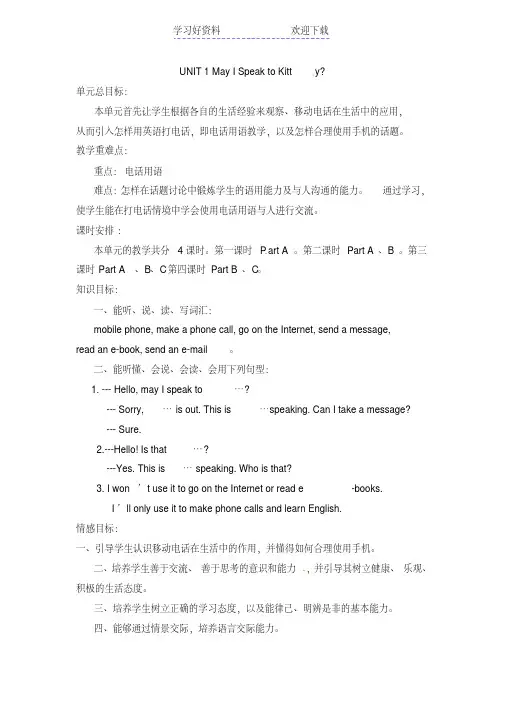
UNIT 1 May I Speak to Kitt y?单元总目标:本单元首先让学生根据各自的生活经验来观察、移动电话在生活中的应用,从而引入怎样用英语打电话,即电话用语教学,以及怎样合理使用手机的话题。
教学重难点:重点:电话用语难点:怎样在话题讨论中锻炼学生的语用能力及与人沟通的能力。
通过学习,使学生能在打电话情境中学会使用电话用语与人进行交流。
课时安排:本单元的教学共分4课时。
第一课时P art A。
第二课时Part A、B 。
第三课时Part A 、B、C第四课时Part B、C。
知识目标:一、能听、说、读、写词汇:mobile phone, make a phone call, go on the Internet, send a message,read an e-book, send an e-mail。
二、能听懂、会说、会读、会用下列句型:1. --- Hello, may I speak to…?--- Sorry, … is out. This is …speaking. Can I take a message?--- Sure.2.---Hello! Is that…?---Yes. This is… speaking. Who is that?3. I won’t use it to go on the Internet or read e-books.I’ll only use it to make phone calls and learn English.情感目标:一、引导学生认识移动电话在生活中的作用,并懂得如何合理使用手机。
二、培养学生善于交流、善于思考的意识和能力,并引导其树立健康、乐观、积极的生活态度。
三、培养学生树立正确的学习态度,以及能律己、明辨是非的基本能力。
四、能够通过情景交际,培养语言交际能力。
第一课时教学目标:1. 能听、说、读、写词汇:mobile phone, make a phone call, go on the Internet, send a message, read an e-book, send an e-mail。
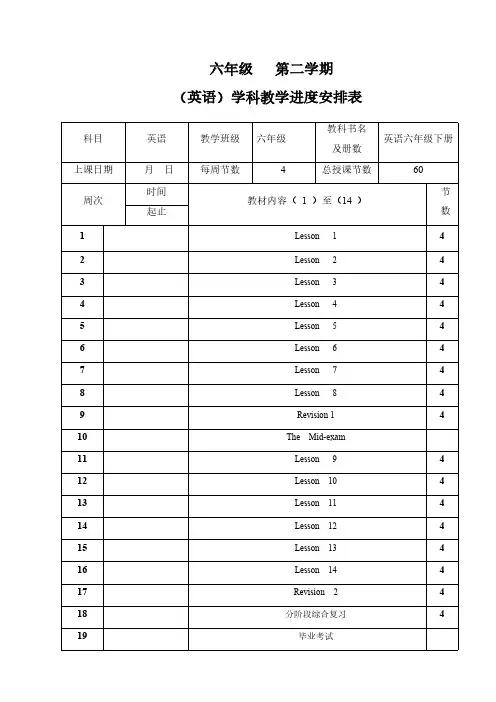
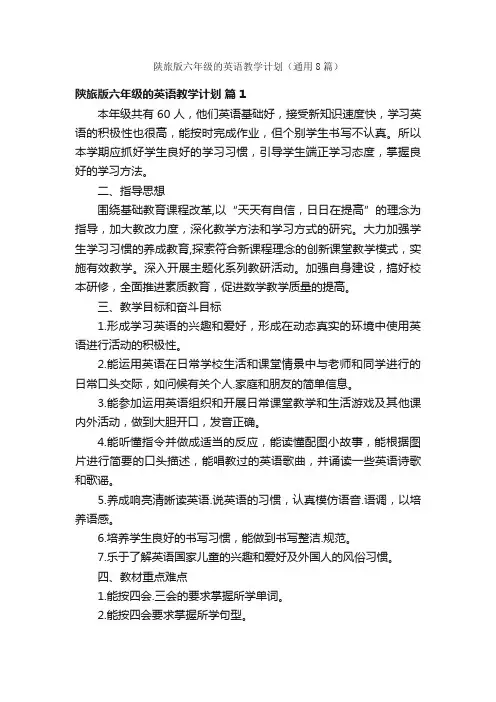
陕旅版六年级的英语教学计划(通用8篇)陕旅版六年级的英语教学计划篇1本年级共有60人,他们英语基础好,接受新知识速度快,学习英语的积极性也很高,能按时完成作业,但个别学生书写不认真。
所以本学期应抓好学生良好的学习习惯,引导学生端正学习态度,掌握良好的学习方法。
二、指导思想围绕基础教育课程改革,以“天天有自信,日日在提高”的理念为指导,加大教改力度,深化教学方法和学习方式的研究。
大力加强学生学习习惯的养成教育,探索符合新课程理念的创新课堂教学模式,实施有效教学。
深入开展主题化系列教研活动。
加强自身建设,搞好校本研修,全面推进素质教育,促进数学教学质量的提高。
三、教学目标和奋斗目标1.形成学习英语的兴趣和爱好,形成在动态真实的环境中使用英语进行活动的积极性。
2.能运用英语在日常学校生活和课堂情景中与老师和同学进行的日常口头交际,如问候有关个人.家庭和朋友的简单信息。
3.能参加运用英语组织和开展日常课堂教学和生活游戏及其他课内外活动,做到大胆开口,发音正确。
4.能听懂指令并做成适当的反应,能读懂配图小故事,能根据图片进行简要的口头描述,能唱教过的英语歌曲,并诵读一些英语诗歌和歌谣。
5.养成响亮清晰读英语.说英语的习惯,认真模仿语音.语调,以培养语感。
6.培养学生良好的书写习惯,能做到书写整洁.规范。
7.乐于了解英语国家儿童的兴趣和爱好及外国人的风俗习惯。
四、教材重点难点1.能按四会.三会的要求掌握所学单词。
2.能按四会要求掌握所学句型。
3.能使用日常交际用语,活用四会句型,进行简单的交流,做到大胆开口,发音正确。
4.能在图片.手势.情境等非语言提示的帮助下,听懂清晰的话语和录音。
陕旅版六年级的英语教学计划篇2一、学习课标,明确教学目标。
为了使我的英语教学适应新时期英语教学要求、树立起新的育人理念,我抽休息时间对《英语课程标准》进行了研读,了解了此次英语课程改革的目的、掌握了此次英语改革的重点、明确了英语课程各级的总目标和各内容的分级目标、理解了英语教学原则、学会了一些科学评价原则等,从而为后面的教学提供了充分的依据、奠定了的扎实的基础、保证了教学的顺利进行。
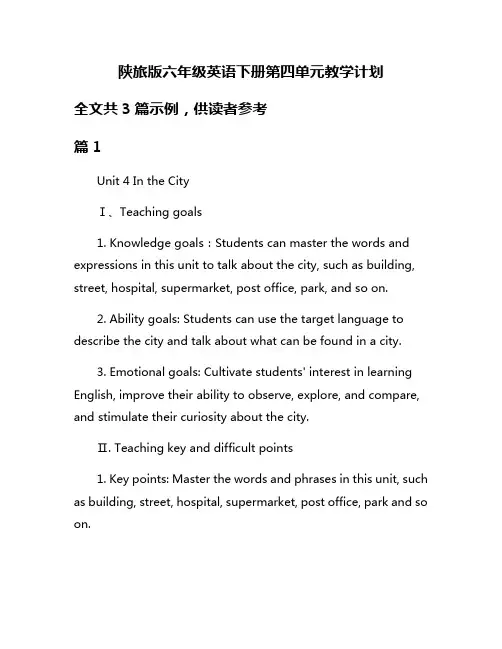
陕旅版六年级英语下册第四单元教学计划全文共3篇示例,供读者参考篇1Unit 4 In the CityⅠ、Teaching goals1. Knowledge goals:Students can master the words and expressions in this unit to talk about the city, such as building, street, hospital, supermarket, post office, park, and so on.2. Ability goals: Students can use the target language to describe the city and talk about what can be found in a city.3. Emotional goals: Cultivate students' interest in learning English, improve their ability to observe, explore, and compare, and stimulate their curiosity about the city.Ⅱ. Teaching key and dif ficult points1. Key points: Master the words and phrases in this unit, such as building, street, hospital, supermarket, post office, park and so on.2. Difficult points: How to use the target language to talk about the city and how to improve students' ability to express themselves.Ⅲ. Teaching methods1. Task-based teaching method. Organize group discussions, pair work, role-play, and other activities to stimulate students' interest in learning and improve their practical English abilities.2. Situational teaching method. Create various city scenes for students to experience and interact in the classroom.Ⅳ. Teaching aids1. PPT courseware, pictures of the city, maps, and other scene-setting aids.2. Classroom decorations to simulate a city environment.Ⅴ. Teaching procedures1. Warm-up (10 minutes)Show pictures of different city landmarks and ask students to guess the names.Ask students to describe what they see in the picture.2. Presentation (15 minutes)Introduce new words such as building, street, hospital, supermarket, post office, park, etc.Teach students how to use these words in sentences.3. Practice (20 minutes)Divide students into groups and let them discuss the question "What can you find in a city?"Each group will then present their findings to the class.4. Consolidation (15 minutes)Play a game of "City Scavenger Hunt" where students have to find different landmarks in the classroom or school.5. Homework assignment (5 minutes)Ask students to write a short paragraph describing their favorite place in the city and what can be found there.Ⅵ. Blackboard design1. Key words: building, street, hospital, supermarket, post office, park2. Target sentence: What can you find in a city?Ⅶ. After class reflectionEvaluate the effectiveness of the teaching process by observing students' participation, understanding, and pronunciation of new words. Make adjustments accordingly for future lessons.篇2陕旅版六年级英语下册第四单元教学计划Unit 4: Making a DifferenceObjectives:1. To introduce and be able to use vocabulary related to making a difference2. To understand and be able to talk about ways to make a positive impact in the community3. To practice reading and writing skills through guided activities4. To develop communication skills through group discussions and presentationsWeek 1:Day 1:- Warm-up activity: Review vocabulary from previous units related to community and giving back- Introduction to new vocabulary: charity, donation, volunteer, fundraising- Pair work: Practice using new vocabulary in sentences- Homework: Write a short paragraph about a time when you helped someone in needDay 2:- Reading comprehension: Read a short passage about a charity event and answer questions- Group discussion: Discuss ways to raise money for a charity in your community- Role play: Act out a conversation between a volunteer and someone interested in donating- Homework: Research a charity organization in your community and write a brief report about their workWeek 2:Day 1:- Vocabulary review: Flashcards and matching game with new words- Writing activity: Write a letter to a charity organization expressing interest in volunteering- Peer editing: Review and make suggestions on classmates' letters- Homework: Practice spelling and pronunciation of new vocabulary wordsDay 2:- Listening activity: Listen to a recording of a fundraising event and fill in missing information- Creative writing: Write a story about a character who made a difference in their community- Group presentation: Share stories and discuss ways to inspire others to get involved- Homework: Prepare a short presentation about a cause you care about and how others can helpAssessment:- Quizzes on vocabulary and reading comprehension- Participation in group discussions and presentations- Writing assignments including letters and reports- Overall engagement and understanding of unit objectivesBy the end of this unit, students should have a better understanding of how they can make a positive impact in their community and be inspired to get involved in charitable work. This unit aims to develop not only English language skills but also a sense of empathy and social responsibility among students.篇3Teaching Plan for Grade Six English, Unit FourI. Objectives:1. Students will be able to identify and use new vocabulary related to transportation.2. Students will be able to ask for and give directions using prepositions of place.3. Students will be able to write simple sentences describing locations and directions.II. Materials:1. Textbook: Shanglv Edition Grade 6 English, Unit 42. Flashcards with pictures of different modes of transportation3. Whiteboard and markers4. Worksheets with exercises related to vocabulary and directionsIII. Activities:1. Warm-up (10 minutes)- Review previous lessons on transportation vocabulary- Play a game of "I Spy" with transportation objects in the classroom- Sing a song related to transportation2. Introduction of New Vocabulary (15 minutes)- Introduce new vocabulary related to transportation: car, bus, train, bicycle, plane, boat- Use flashcards and pictures to help students remember the words- Practice pronunciation and spelling of the new vocabulary3. Practice Asking for and Giving Directions (20 minutes)- Review prepositions of place: next to, behind, in front of, between, on, under- Model and practice asking for and giving directions using the new vocabulary (e.g. "Where is the bus station?" "The bus station is next to the library.")- Provide scenarios for students to practice giving directions to a partner4. Writing Exercise (15 minutes)- Distribute worksheets with blank maps and ask students to write sentences describing locations and directions (e.g. "The post office is between the bank and the supermarket.")- Monitor students as they work and provide feedback on their writing5. Speaking Activity (20 minutes)- Divide students into pairs and give each pair a map with locations marked- Ask students to take turns giving directions to each other using the vocabulary and prepositions they have learned- Encourage students to use complete sentences and ask for clarification when needed6. Review and Assessment (10 minutes)- Review key vocabulary and phrases from the lesson- Ask students to summarize what they have learned about transportation and giving directions- Administer a short quiz to assess students' understanding of the material covered in the lessonIV. Homework:- Assign students a writing task to describe the location of their school and give directions from their home to school using the vocabulary and prepositions learned in class.Overall, this lesson plan is designed to engage students in actively using the new vocabulary and grammar structures in practical contexts. By combining speaking, writing, and listening activities, students will have multiple opportunities to practice and reinforce their language skills related to transportation and giving directions.。
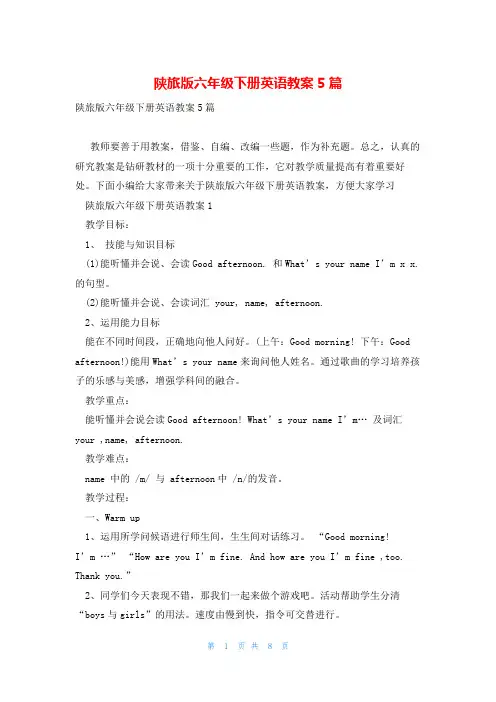
陕旅版六年级下册英语教案5篇陕旅版六年级下册英语教案5篇教师要善于用教案,借鉴、自编、改编一些题,作为补充题。
总之,认真的研究教案是钻研教材的一项十分重要的工作,它对教学质量提高有着重要好处。
下面小编给大家带来关于陕旅版六年级下册英语教案,方便大家学习陕旅版六年级下册英语教案1教学目标:1、技能与知识目标(1)能听懂并会说、会读Good afternoon. 和What’s your name I’m x x.的句型。
(2)能听懂并会说、会读词汇 your, name, afternoon.2、运用能力目标能在不同时间段,正确地向他人问好。
(上午:Good morning! 下午:Good afternoon!)能用What’s your name来询问他人姓名。
通过歌曲的学习培养孩子的乐感与美感,增强学科间的融合。
教学重点:能听懂并会说会读Good afternoon! What’s your name I’m… 及词汇your ,name, afternoon.教学难点:name 中的 /m/ 与 afternoon中 /n/的发音。
教学过程:一、Warm up1、运用所学问候语进行师生间,生生间对话练习。
“Good morning!I’m …” “How are you I’m fine. And how are you I’m fine ,too. Thank you.”2、同学们今天表现不错,那我们一起来做个游戏吧。
活动帮助学生分清“boys与girls”的用法。
速度由慢到快,指令可交替进行。
二、Lead inOK!boys and girls ,you’ve done a good job. Look!老师左右手各持一手偶,通过变换音调来演一段对话,引出本课重点:What’s your name 手偶1:Hi, I’m Mr.Li . What’s your name 手偶2: Hello, I’m Sam.三、Text teaching1、同学们现在我是Mr.Li不是Ms.Liu,老师说话的声音变粗。
Lesson 1 Xi‟an is a beautiful city.本课谈论的是旅游方面的话题,对话内容侧重于旅游前的准备活动。
通过学习使学生乐于并能主动和别人用英语谈论旅游的话题。
学生要掌握一些和旅游活动相关的句子和短语,例如Where are you going?\ Who will take you there?\Are you ready for your trip?\ have a good time.还有学生要会说一些旅游景点的名称。
例如,Qinshihuang‟s Terra-cotta Warriors and Horses(兵马俑),the Gteat Wall(长城), the Bell Tower(钟楼), the West Lake(西湖)。
教学目的及重难点分析:1. 会说会用这些句子:Where are you going ? I‟m going to …(名胜古迹名称)Who will take you there?2. 能听懂会说会用名胜古迹名称:Qin Shihuang‟s Terra-cotta Warriors and Horses; The Bell Tower; the Great Wall; the Weat Lake.3.理解会用一般将来时态的两种表达法:I‟m going to …\ I will…4. 会说会用常用语:take a picture of…\ be ready for \have a good time课前准备:1. 教师准备一些同学们都比较熟悉的景点照片或CAI 课件图片:兵马俑,钟楼,长城,西湖等。
2. 同学们准备一些和爸爸妈妈一起照的景点合影。
教学过程:教师通过手偶A和B的对话引出本课所要学习的重点句型和重点短语。
A:What are you doing now?B: I‟m buying a train ticket. Why are you here?A: I want to buy a train ticket, too.B: Where are you going?A: I‟m going to go to Sichuan.B: Who will take you there?A: My brother. Where are you going?B: Beijing. I‟ll visit my grandparents.A: Beijing is a famous city. Do take more photos and have a good time.B: Thank you . The same to you.A: Goodbye.B: Byebye.教师利用CAI课件上的景点图片或是照片讲解本课重点词汇和句型。
陕旅版六年级下册英语教学计划思维导图简单全文共3篇示例,供读者参考篇1A Simple Mind Map of the Teaching Plan for Grade 6 Volume2 English (Shaan Travel Version)As a sixth-grader, the second volume of our English textbook is both exciting and challenging. The Shaan Travel version covers a wide range of topics that not only expand our vocabulary and grammar knowledge but also expose us to different cultures and ways of thinking. To help me better understand and organize the content, I've created a simple mind map of the teaching plan. Let me walk you through it!Unit 1: Making PlansAt the heart of this unit is the theme of making plans for various occasions. We learn how to express future plans using "will" and "going to", as well as discuss reasons for making certain choices. The vocabulary revolves around activities, seasons, and holidays, enabling us to talk about our plans for different times of the year.Unit 2: Keeping HealthyThis unit focuses on the importance of maintaining a healthy lifestyle. We study vocabulary related to food, exercise, and general well-being. The grammar points cover imperatives (for giving advice and instructions) and modal verbs like "should" and "must" (for expressing obligation and necessity). It's an engaging unit that encourages us to adopt healthy habits.Unit 3: Protecting the EnvironmentAs responsible global citizens, we learn about environmental issues and ways to protect our planet. The vocabulary includes words related to nature, pollution, and conservation efforts. We also practice using the present perfect tense to talk about experiences and achievements. This unit raises our awareness and motivates us to take action.Unit 4: Traveling AroundWho doesn't love to travel? In this unit, we explore different modes of transportation, tourist attractions, and travel experiences. The vocabulary covers means of transport, landmarks, and travel-related phrases. We also learn how to use prepositions of movement and the past continuous tense to describe ongoing actions in the past. It's a unit that fuels our wanderlust!Unit 5: Telling StoriesStorytelling is a fundamental part of human culture, and this unit delves into the art of narrating stories. We study vocabulary related to plot elements, characters, and settings. The grammar focuses on using reported speech to recount dialogues and events. It's a unit that nurtures our creative expression and appreciation for literature.Unit 6: Exploring Careers篇2Title: Simple Mind Map for English Teaching Plan (Shaanxi Travel Edition, Lower 6th Grade)IntroductionHey there, friends! As we're nearing the end of this school year, I thought I'd share my simple mind map for the English teaching plan we've been following in our Shaanxi Travel Edition textbooks. It's been a fun journey, and I've learned so much! Let's dive right in.Main UnitsUnit 1: Hello, New World!Greeting othersIntroducing oneself and others Spelling namesNumbers 0-100Unit 2: My DayDaily routinesTelling timeSchool subjects Extracurricular activitiesUnit 3: Delicious Food Names of common foods Expressing likes/dislikes Making requests politely Reading menusUnit 4: Pastimes and Hobbies Favorite activities and games Sports and exerciseIndoor vs outdoor hobbiesFuture plans and dreamsUnit 5: Going PlacesMeans of transportationReading maps and giving directions Describing locationsPopular travel destinationsUnit 6: People and CulturesPhysical descriptionsPersonality traitsCultural traditions and customsRespecting diversityTeaching Methods→ Interactive class discussions→ Role plays and skits→ Vocabulary games (e.g. Hangman, Charades)→ Listening to stories and songs→ Watching short videosLanguage Skills⤷ Listening comprehension⤷ Speaking fluency⤷ Reading for understanding⤷ Writing simple textsVocabulary« High-frequency words« Topic-related terms« Idioms and expressionsGrammar Points• Subject-verb agreement• Basic tenses (present, past, future)• Prepositions of place and time• Question words (who, what, where, etc.) Projects and Activities♦ Designing menus for a restaurant♦ Creating travel brochures♦ Interviewing partners about hobbies♦ Show-and-tell cultural objectsReview and Assessment☑ Weekly quizzes and tests☑ Homework assignments☑ End-of-unit projects☑ Final exam at the endThat's my simple mind map for our English teaching plan this year! It's been an awesome experience learning with all of you. I'm already excited for what next year will bring! Let me know if you have any other questions.篇3Title: A Student's Perspective: A Simple Mind Map for Our Grade 6 English Teaching PlanAs a 6th grade student, I always look forward to our English classes. Learning a new language is both exciting and challenging, but our teacher makes it fun and engaging. Recently, she introduced us to the teaching plan for the second semester, and I must admit, at first glance, it seemed a bit overwhelming.However, she presented it in the form of a mind map, which made it so much easier to understand and follow.Let me walk you through this mind map and share my thoughts on the different sections.I. Warm-up and ReviewAt the center of the mind map, we have the "Warm-up and Review" section. This is where we start each lesson by recapping what we learned previously and getting our minds ready for the new material. Our teacher often uses games, songs, or interactive activities to make this part enjoyable and effective.II. Main Teaching ContentBranching out from the center, we have the "Main Teaching Content" section, which is further divided into severalsub-sections:VocabularyLearning new words is an essential part of mastering a language. In this section, we'll focus on expanding our vocabulary related to various topics covered in the textbook. Our teacher uses various techniques, such as flashcards, word associations, and context clues, to help us learn and remember the new words effectively.GrammarGrammar can be a bit tricky, but our teacher makes it understandable and relatable. In this section, we'll learn about different grammatical structures, such as tenses, sentence patterns, and parts of speech. She often uses examples from our daily lives to help us grasp the concepts better.Reading ComprehensionReading is one of the best ways to improve our English skills. In this section, we'll read and analyze different texts, ranging from short stories to articles. Our teacher encourages us to discuss the main ideas, make predictions, and share our thoughts on the reading materials. This not only improves our comprehension but also enhances our critical thinking skills.WritingWriting is another essential aspect of language learning. In this section, we'll learn how to express our thoughts and ideas in written form. We'll practice different writing styles, such as descriptive, narrative, and expository writing. Our teacher provides us with writing prompts and guidelines, and we often peer-review each other's work, which helps us learn from one another.Listening and SpeakingEffective communication involves not only reading and writing but also listening and speaking. In this section, we'll engage in various listening and speaking activities, such asrole-plays, discussions, and presentations. Our teacher encourages us to practice conversational English and improve our pronunciation and fluency.III. Practice and ReinforcementAfter covering the main teaching content, we move on to the "Practice and Reinforcement" section. This is where we solidify our understanding of the concepts we've learned. Our teacher provides us with a variety of exercises, worksheets, and projects to reinforce our knowledge and skills.IV. Assessment and FeedbackThe final section of the mind map is "Assessment and Feedback." Here, our teacher evaluates our progress and provides us with constructive feedback. We take quizzes, tests, and complete assignments that help our teacher identify areas where we need more support or practice.As a student, I appreciate the clear and organized structure of this mind map. It helps me visualize the overall teaching planand understand how the different components are interconnected. The mind map also serves as a useful reference tool, allowing me to quickly locate and review specific sections as needed.Moreover, the mind map's simplicity and use of visuals make it easy for me to follow and understand. The colors, shapes, and icons help to organize the information in a way that appeals to different learning styles, making it accessible to a diverse group of students.Overall, I find this mind map to be an excellent tool for our English learning journey. It not only provides a clear roadmap for our lessons but also encourages us to be active participants in the learning process. With the help of our dedicated teacher and this well-structured teaching plan, I'm confident that we'll make significant progress in mastering the English language by the end of the semester.。
陕旅英语六年级下册教案在英语教学过程中,可以给学生多设置一些场景,然后让学生自己组织对话来演示。
作为一名六年级英语老师,你知道如何写六年级英语教案?它能帮助你更好开展教学活动。
你是否在找正准备撰写“陕旅英语六年级下册教案”,下面收集了相关的素材,供大家写文参考!陕旅英语六年级下册教案1TeachingAims(教学目标)学生可以掌握单词及字母:boy,girl,egg,fan,Ee,Ff学生可理解使用句型:AreyouKitty?Yes,Iam./No,Iamnot.TeachingImportances(教学重点)boy,girl,egg,fan,Ee,FfTeachingDifficulties(教学难点)AreyouKitty?Yes,Iam./No,Iamnot.CultivationEducationTrainingPoints(养成教育训练点):继续培养学生对英语的学习兴趣,帮助学生逐步养成善于观察、勇于表现的好习惯,引导学生发现身边的英语。
TeachingMethods(教学方法)游戏法,小组竞赛法,情境法TeachingTools(教学用具)多媒体课件TeachingProcedures(教学过程)Pre—taskpreparations1.播放音乐,带领学生朗读儿歌,感受Areyou…?句型。
Areyouaboy?Areyouaboy?Yes,Iam.Yes.Iam.Areyouagirl?Areyouagirl?No,I;;mnot.No,I;;mnot.2.请个别学生用课时一学过的句子介绍自己。
S1:Hi,I;;m…(name).I;;ma…(boy/girl).While-taskprocedures1.出示Listenandsay的图片,播放录音或多媒体动画,让学生跟读对话。
板书句型Areyou…?Yes,Iam./No,I;;mnot.让学生跟读,然后通过提问帮助学生理解该句型的用法。
陕旅六年级英语下册教案3篇陕旅六年级英语下册教案篇1教学内容:1.词汇(1)复习关于职业的词汇:doctor, teacher, nurse, cook, fireman, driver, policeman, pilot, singer.(2)学习生词:astronaut, coach, actor (actress),writer.2.功能句型(1)复习询问他人职业及回答:What does he/she do? He/She is a/an …。
(2)学习询问对方将来想要从事的工作及回答:What do you want to be when you grow up?I want to be a/an …。
教学目标:1.知识目标(1)能掌握和职业相关的一些词汇,并能在相应的功能句型中熟练运用;(2)能在恰当的情景下熟练运用关于询问他人的职业及回答的交际用语;(3)能在相应的情景下熟练地运用关于询问对方将来想要从事的工作及回答的交际用语。
2.能力目标(1)通过学习和操练,使学生能掌握本课所学关于职业的词汇,能熟练询问他人的职业及对将来工作的理想,并做出相应的回答;(2)在学习过程中培养学生发现问题和解决问题的能力,提高自学能力;3.策略目标(1)帮助学生学会与人合作,共同完成学习任务;(2)帮助学生学会观察生活中标的英语,学会借助词典来学习。
4.其他目标(1)在学习职业名称的过程中了解“感动中国的2021年度人物”,潜移默化地为学生树立榜样;(2)在小组学习和帮助他人学习的同时,培养学生乐于助人,热爱集体的良好品质;(3)通过多种形式的游戏和活动,激发学生英语学习兴趣。
教学重点:1.重点词汇:astronaut, coach, actor (actress), writer.2.重点句型:What do you want to be? I want to bea/an …。
教学难点:1.正确朗读和运用关于职业的词汇。
陕陕旅旅版版六六年年级级英英语语上上册册教教学学计计划划
一一、、指指导导思思想想::
以以培培养养小小学学生生的的英英语语表表达达能能力力为为宗宗旨旨,,让让学学生生在在学学习习中中了了解解英英语语,,学学会会简简单单的的英英语语口口语语,,并并将将它它运运用用于于生生活活中中,,学学会会简简单单的的交交流流,,对对话话,,将将英英语语口口语语运运用用于于生生活活。
二二、、学学生生情情况况分分析析::
这这学学期期我我担担任任六六年年级级的的英英语语教教学学 ,,共共有有学学生生88人人,,二二位位学学生生思思维维敏敏捷捷,,且且对对英英语语学学习习比比较较感感兴兴趣趣,,学学生生课课堂堂表表现现积积极极、、主主动动,,乐乐于于参参与与,,乐乐于于表表现现自自己己((尤尤其其以以女女生生为为主主))。
但但两两位位男男生生基基础础较较差差,,而而且且生生性性比比较较懒懒惰惰,,不不爱爱背背,,不不爱爱读读,,在在教教学学中中要要充充分分考考虑虑他他们们的的接接受受能能力力,,给给他他们们适适当当压压力力,,想想办办法法帮帮助助他他们们尽尽快快提提高高,,学学好好英英语语。
本本年年级级优优等等生生和和较较差差的的人人数数所所占占比比例例较较少少,,中中等等生生所所占占人人数数较较多多,,成成绩绩差差距距不不大大。
但但由由于于新新课课程程改改革革的的实实施施,,教教学学方方法法有有很很大大变变动动,,由由于于受受硬硬件件设设施施的的限限制制,,好好多多教教学学活活动动都都没没实实施施。
所所以以导导致致课课堂堂氛氛围围压压抑抑沉沉闷闷。
三三、、教教材材分分析析::
教教材材强强调调语语言言的的运运用用,,注注重重能能力力的的培培养养,,突突出出了了兴兴趣趣的的激激发发,,重重视视双双向向交交流流,,融融合合学学科科内内容容,,重重视视灵灵活活扩扩展展,,实实现现整整体体设设计计。
吸吸收收了了当当今今国国内内外外把把英英语语作作为为外外语语教教学学的的理理论论和和成成功功的的经经验验,,把把这这些些教教学学理理论论和和实实践践经经验验同同我我国国小小学学英英语语教教学学的的实实际际有有机机结结合合起起来来,,形形成成了了适适合合我我国国英英语语教教学学基基本本状状况况的的模模式式和和方方法法。
本本册册教教材材分分为为88个个单单元元,,每每个个单单元元分分四四个个课课时时,,总总计计3322课课时时。
全全书书主主要要根根据据小小学学生生的的年年龄龄、、心心理理特特点点和和生生活活实实践践,,通通过过形形式式多
多
样样的的话话题题、、丰丰富富多多彩彩的的语语境境活活动动、、活活泼泼有有趣趣的的儿儿歌歌和和歌歌曲曲,,加加上上课课文文中中生生动动幽幽默默的的卡卡通通图图画画,,让让学学生生轻轻松松愉愉快快地地感感知知英英语语学学习习英英语语,,达达到到掌掌握握英英语语运运用用英英语语的的目目的的。
四四、、教教学学目目标标::
11、、能能听听懂懂、、会会说说对对话话,,并并能能进进行行简简单单的的交交流流。
22、、能能听听、、说说、、认认读读单单词词和和词词组组并并能能听听、、说说、、读读、、写写并并简简单单运运用用。
33、、能能听听、、做做T T P P R R 活活动动。
44、、能能学学会会小小制制作作。
55、、能能唱唱课课本本上上的的歌歌曲曲。
66、、能能听听、、说说、、唱唱77首首歌歌谣谣。
77、、能能完完成成自自我我评评价价活活动动。
88、、能能听听懂懂并并阅阅读读小小故故事事。
99、、能能了了解解简简单单的的中中西西方方文文化化知知识识。
五五、、教教学学措措施施::
11、、融融会会话话教教学学与与情情景景表表演演之之中中。
22、、巧巧用用实实物物、、头头饰饰、、卡卡片片、、c c h h a a n n t t 等等来来帮帮助助进进行行单单词词教教学学。
33、、利利用用读读写写课课等等时时间间对对学学生生进进行行单单词词书书写写的的指指导导。
44、、注注重重学学生生英英语语思思维维能能力力的的培培养养,,尽尽可可能能让让学学生生形形 象象的的感感知知语语言言,,形形成成一一定定的的英英语语思思维维。
55、、调调动动学学生生学学习习的的积积极极性性,,鼓鼓励励学学生生主主动动参参与与到到课课堂堂教教学学中中去去。
66、、丰丰富富学学生生的的课课余余生生活活,,让让英英语语贯贯穿穿学学生生的的生生活活中中。
六六、、教教学学进进度度安安排排。